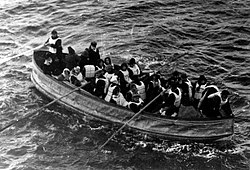This article's use of external links may not follow Wikipedia's policies or guidelines. (July 2023) |


Lifeboats played a crucial role during the sinking of the Titanic on 14–15 April 1912. The ship had 20 lifeboats that, in total, could accommodate 1,178 people, a little over half of the 2,209 on board the night it sank.
18 lifeboats were used, loading between 11:45 P.M. and 2:05 A.M., though Collapsible Boat A floated off the ship's partially submerged deck and Collapsible Boat B floated away upside down minutes before the ship upended and sank.
Many lifeboats only carried a fraction of their maximum capacity which, depending on type, was 40, 47, or 65 people. There are many versions as to the reasoning behind half-filled lifeboats. Some sources[which?] suggested apprehensions that the lifeboats could buckle under the weight. Others suggested it was because the crew was following orders to evacuate women and children first. As the half-filled boats rowed away from the ship, they were too far away for other passengers to reach, and most lifeboats did not return to the wreck due to a fear of being swamped by drowning victims or the suction of the sinking ship. Only Lifeboats No. 3 and No. 15 returned to retrieve survivors from the water, some of whom later died.
The closest ship to respond to the Titanic's distress signals, the RMS Carpathia, did not reach the lifeboats until 4 A.M., one hour and forty minutes after the Titanic sank. According to generally accepted reports[specify], the rescue continued until the last lifeboat was collected at 8:30 A.M.
Although the number of lifeboats was insufficient, Titanic complied with maritime safety regulations at the time. The sinking showed that the regulations were outdated for such large passenger ships. The inquiry also revealed that White Star Line wanted fewer lifeboats on the decks to provide unobstructed views for passengers and to give the ship more aesthetic appeal when seen from an exterior viewpoint. In the event of an emergency, it was not anticipated that all passengers and crew would require evacuation at the same time; it was believed that Titanic could float long enough to allow a transfer of passengers and crew to a rescue vessel.[citation needed]
Compounding the disaster, Titanic's crew was poorly trained on using the davits (lifeboat launching equipment). As a result, lifeboat launches were slow, improperly executed, and poorly supervised. These factors contributed to several lifeboats leaving with only half their capacity.
A total of 1,503 people lost their lives when the Titanic sank in the North Atlantic Ocean. Many of them had not made it into a boat. Only 706 people survived in the lifeboats until later that morning when they were rescued by the RMS Carpathia. Those aboard the lifeboats were picked up by Carpathia over the course of 4 hours and 30 minutes, from about 4 A.M. to 8:30 A.M., and 13 of the lifeboats were also taken aboard. The lifeboats were returned to the White Star Line at New York Harbor, as they were the only items of value salvaged from the shipwreck, but subsequently vanished from history over time.